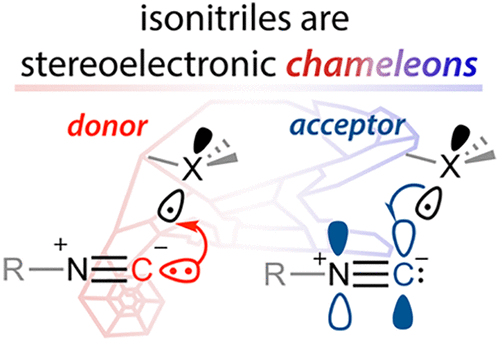当前位置:
X-MOL 学术
›
J. Am. Chem. Soc.
›
论文详情
Our official English website, www.x-mol.net, welcomes your
feedback! (Note: you will need to create a separate account there.)
Isonitriles as Stereoelectronic Chameleons: The Donor-Acceptor Dichotomy in Radical Additions
Journal of the American Chemical Society ( IF 14.4 ) Pub Date : 2018-10-01 , DOI: 10.1021/jacs.8b08513 Gabriel dos Passos Gomes 1 , Yulia Loginova 2 , Sergey Z. Vatsadze 2 , Igor V. Alabugin 1
Journal of the American Chemical Society ( IF 14.4 ) Pub Date : 2018-10-01 , DOI: 10.1021/jacs.8b08513 Gabriel dos Passos Gomes 1 , Yulia Loginova 2 , Sergey Z. Vatsadze 2 , Igor V. Alabugin 1
Affiliation

|
Radical addition to isonitriles (isocyanides) starts and continues all the way to the transition state (TS) mostly as a simple addition to a polarized π-bond. Only after the TS has been passed, the spin density moves to the α-carbon to form the imidoyl radical, the hallmark intermediate of the 1,1-addition-mediated cascades. Addition of alkyl, aryl, heteroatom-substituted, and heteroatom-centered radicals reveals a number of electronic, supramolecular, and conformational effects potentially useful for the practical control of isonitrile-mediated radical cascade transformations. Addition of alkyl radicals reveals two stereoelectronic preferences. First, the radical attack aligns the incipient C···C bond with the aromatic π-system. Second, one of the C-H/C-C bonds at the radical carbon eclipses the isonitrile N-C bond. Combination of these stereoelectronic preferences with entropic penalty explains why the least exergonic reaction (addition of the t-Bu radical) is also the fastest. Heteroatomic radicals reveal further unusual trends. In particular, the Sn radical addition to the PhNC is much faster than addition of the other group IV radicals, despite forming the weakest bond. This combination of kinetic and thermodynamic properties is ideal for applications in control of radical reactivity via dynamic covalent chemistry and may be responsible for the historically broad utility of Sn radicals ("the tyranny of tin"). In addition to polarity and low steric hindrance, radical attack at the relatively strong π-bond of isonitriles is assisted by "chameleonic" supramolecular interactions of the radical center with both the isonitrile π*-system and lone pair. These interactions are yet another manifestation of supramolecular control of radical chemistry.
中文翻译:

作为立体电子变色龙的异腈:自由基添加中的供体-受体二分法
对异腈(异氰化物)的自由基加成开始并一直持续到过渡态 (TS),主要是作为对极化 π 键的简单加成。只有在通过 TS 后,自旋密度才会移动到 α-碳以形成亚氨基,这是 1,1-加成介导的级联反应的标志性中间体。添加烷基、芳基、杂原子取代的和以杂原子为中心的自由基揭示了许多电子、超分子和构象效应,可能对异腈介导的自由基级联转化的实际控制有用。烷基的加成揭示了两种立体电子偏好。首先,自由基攻击使初始的 C···C 键与芳香族 π 系统对齐。其次,自由基碳上的 CH/CC 键之一使异腈 NC 键黯然失色。这些立体电子偏好与熵惩罚的结合解释了为什么最少的放能反应(添加 t-Bu 自由基)也是最快的。杂原子自由基揭示了进一步的异常趋势。特别是,尽管形成最弱的键,但添加到 PhNC 的 Sn 自由基比添加其他 IV 族自由基要快得多。这种动力学和热力学特性的组合非常适用于通过动态共价化学控制自由基反应性的应用,并且可能是 Sn 自由基在历史上广泛使用的原因(“锡的暴政”)。除了极性和低位阻之外,对异腈相对强的 π 键的自由基攻击还得到了“变色龙”的帮助 自由基中心与异腈 π* 系统和孤对电子的超分子相互作用。这些相互作用是自由基化学超分子控制的另一种表现。
更新日期:2018-10-01
中文翻译:

作为立体电子变色龙的异腈:自由基添加中的供体-受体二分法
对异腈(异氰化物)的自由基加成开始并一直持续到过渡态 (TS),主要是作为对极化 π 键的简单加成。只有在通过 TS 后,自旋密度才会移动到 α-碳以形成亚氨基,这是 1,1-加成介导的级联反应的标志性中间体。添加烷基、芳基、杂原子取代的和以杂原子为中心的自由基揭示了许多电子、超分子和构象效应,可能对异腈介导的自由基级联转化的实际控制有用。烷基的加成揭示了两种立体电子偏好。首先,自由基攻击使初始的 C···C 键与芳香族 π 系统对齐。其次,自由基碳上的 CH/CC 键之一使异腈 NC 键黯然失色。这些立体电子偏好与熵惩罚的结合解释了为什么最少的放能反应(添加 t-Bu 自由基)也是最快的。杂原子自由基揭示了进一步的异常趋势。特别是,尽管形成最弱的键,但添加到 PhNC 的 Sn 自由基比添加其他 IV 族自由基要快得多。这种动力学和热力学特性的组合非常适用于通过动态共价化学控制自由基反应性的应用,并且可能是 Sn 自由基在历史上广泛使用的原因(“锡的暴政”)。除了极性和低位阻之外,对异腈相对强的 π 键的自由基攻击还得到了“变色龙”的帮助 自由基中心与异腈 π* 系统和孤对电子的超分子相互作用。这些相互作用是自由基化学超分子控制的另一种表现。


















































 京公网安备 11010802027423号
京公网安备 11010802027423号